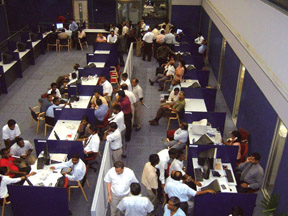|
observer |
|
|
|
|
|
OTHER LINKS |

|

|

|
Business sector continues unhinderedA year ago Prime Minister and SLFP presidential election candidate Mahinda Rajapaksa presented his election manifesto Mahinda Chinthana as his policy frame work for six years. The contents of the manifesto went through comments, analysis and heavy criticism during the election campaign and finally approved by the majority of the people.
Mahinda Chintana policies were not entirely new economic policies or reverse policies of the UPFA government when it came into power in 2004 when Mahinda Rajapaksa was the Prime Minister. President Rajapaksa expanded and continued the UPFA manifesto Rata Perata presented at the general election. Rata Perata policy statement of the UPFA and Mahinda Chintana are important turning points of the economic policies in the recent history of Sri Lanka. It was the first time after two and half decades that the country trusted its own resources and strengths as the major forces of economic development. It was the first time after the introduction of the open economic policies the country stressed on the development of agriculture sector and the rural economy. It considered the SME sector as the back bone of the economy. These policies were welcomed by the business community because it did not turn the economy into a closed inward-oriented model as predicted by the Opposition. It considered the private sector as the engine of the economy and the government as the facilitator. This was witnessed during last year by many indicators. Colombo Stock Exchange (CSE) recorded impressive performance during the year and the All Share Price Index (ASPI), Milanka Price Index have recorded highest figures in the history. ASPI increased by 697.1 points or 36.2% and Milanka by 993.1 points or 40.5% during the year and market capitalisation passed Rs. 800 billion. Mahinda Chintana planned to achieve a realistic economic growth rate of 8% over the next six year period. During the year the country achieved over 7%. The last recorded growth of this magnitude was in 1978, almost 30 years ago. Country achieved this growth under adverse internal and external conditions such as impacts of tsunami disaster, high oil price and the war. Economic analysts said that the next year growth rate would exceed 8%. "Mahinda Chintana" clearly ruled out extreme neoliberal policies and said that mere reduction of public expenditure and the resulting reduction of the budget deficit is not a characteristic of prudent public finance management. It emphasises direct government expenditure to essential priority areas and thereby ensuring maximum returns to the national economy. Soon after the victory, President Rajapaksa presented the new budget (the second budget within one month) and allocated money to implement what he promised. Salary for State employees was increased to achieve the high productivity target. Government increased expenditure on infrastructure development as well as education, health and relief for marginalised people. Simultaneously to maintain budget deficit and increase revenue government simplified tax system and improved the efficiency in the tax collection. As a result the government revenue increased and achieved the expected revenue target during the first 9 months. Mahinda Chintana emphasised the need for a strong government sector and clearly says that the strategically important State-owned institutions such as Electricity Board, banks, transport would not be privatised. This was one of the issues that created political disputes on many occasions. But, public ownership of these institutions would not solve the present crisis. They should be modernised to cater to the needs of the private sector and make the government a true facilitator of economic development. Last year government practically showed its commitment on this aspect. Mega infrastructure projects which were pending for several decades due to various political and social issues were kick started and work is now progressing. Upper Kotmale and Norochcholai power projects, Weeravila international airport, Hambantota harbour, Colombo South port are some of them and 2007 budget has allocated money for the undertakings. It was argued that there are so many concessions and relief packages in the Mahinda Chintana and some sections questioned how the government was going to finance them. However within one year it has been proved that the Mahinda Chintana is not a cheap package of popular election promises. .................................. |
 After one year it is time to take stock of what Mahinda Chintana has
achieved in the economic frontier and analyse whether these economic
policies deliver what people expect.
After one year it is time to take stock of what Mahinda Chintana has
achieved in the economic frontier and analyse whether these economic
policies deliver what people expect. 







